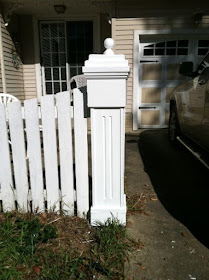I eventually settled on a white picket fence, which runs only about 8 feet on either side of the driveway, connecting to the house at one side and ending at the property line on the other, then turning back along the boundary there for about 15 feet before ending even-up with the front of the garage. The result was a nice, semi enclosed space, where I could keep a table and chairs on one side and storage/waste bins on the other, all hidden behind a 3 foot fence.
To frame it all off properly, I asked the fence contractor to include some large gate posts on either side of the driveway; something about five feet high and reasonably substantial—about 8” to 12” square. I may have given him a rough sketch, but the design he came up with was almost exactly what I was looking for.
 |
| Here you can see the way the fence was designed to wrap around the house and tie it into the landscape. |
I was rather happy with the finished result—the fence really served to “anchor” the house and integrate it into the landscape. It also made it appear larger, since it visually stretched the house and the attached fence all the way across the 90 foot lot.
Maintenance & Durability
While the pickets were of cedar and the rest of the fence framing were of pressure-treated lumber, I was concerned that the three large gateposts might be a long term problem due to the fact that their upper portions were not constructed from treated lumber, but shop built off site from standard 2” thick framing pine. They were well-built, with mitered corners, neat moldings and tight joints, but I knew eventually that the weather (and the carpenter ants) might take their toll.
 |
| You can see how the upper portion has taken a real beating. |
This wasn’t the only issue. Many of the nails used to construct these columns were rusting away, with the result that the lower portions—which were built from 1” thick pressure treated lumber—were coming loose from the bottom of the posts, too. As for the balance of the fence, it was still in good shape; the cedar posts would just need a light sanding and maybe a few nails here and there, and the other standard 4x4 posts were solid as a rock. Nevertheless, as I looked at the fence this spring, I knew that it was time for a major restoration.
Planning & Materials
The ground post anchors that the large columns were built upon were still sound; the fluted sides of the columns were cedar, and in very good shape, as was the edge molding at the corners, which only needed a few new nails. Even the horizontal tops of the posts and the finials were not rotted—some straightening, a screw here and there, and some sanding and re-sealing with silicone caulk would bring them up to snuff.
The upper column panels and the molded trim were another story. They had to go, and not wanting to do this job again, I purchased some Azek PVC trim to do the repair work.
The material is not cheap, but it is a dream to work with—it saws better than wood and takes screws better than wood, too. I wouldn’t use it in every application, but here, where it is painted white anyway and is so exposed to the elements, I have no reservations.
 |
| Rebuilt, Re-fastened, caulked and new paint. |
As for the bottom of the posts, the mitered 1” thick panels were re-attached with some new screws and also some stainless L-brackets screwed in at each corner. Not quite as neat as the original, but very secure and will end up being hidden by paint and the flowers which grow in front of the fence.
Hopefully the result--with regular maintenance--should hold up for a good while longer. We can only hope; the core materials still seem pretty sound, and the post remain well-anchored.
That’s Part One of our fence project. Part two will involve some spade work, as we revitalize the plantings in front of and behind the fence.

No comments:
Post a Comment
Thanks for your comment!